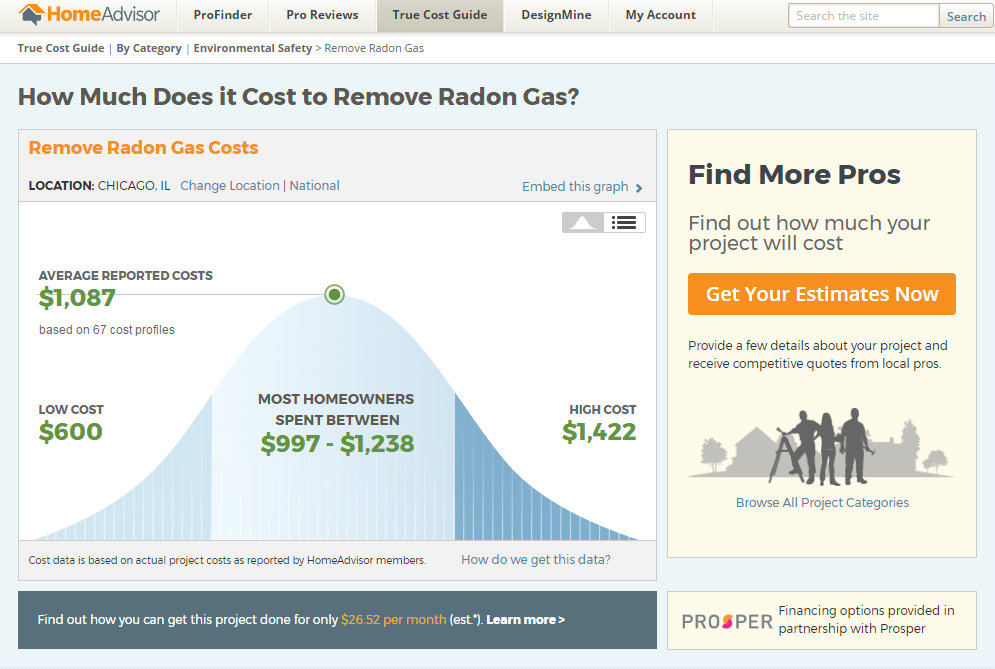Here is some great general information about Radon Gas in the home, how to mitigate, and more.

All of the following statements have been produced by HomeAdvisor.com http://www.homeadvisor.com/cost/environmental-safety/remove-radon-gas/?prevPage=PR# (this based on zip 60067, Palatine).
“Radon gas removal is common in both newer and older homes. Removal techniques range from naturally ventilating the home to reduce a build-up of the gas to depressurizing techniques. Removing radon gas is essential for the health of all occupants in the home.
What is Radon Gas?
Radon gas is odorless and invisible to the human eye. It is a radioactive gas that occurs naturally deep within the soil. It is formed by the natural decay of uranium in rock and soil deep in the earth.
Radon is found in every state and moves through the air and water. It has a decay life of approximately 4 days, which can build up over time depending on ventilation. The health risks of radon gas can lead to a risk in lung cancer. Short-term effects include shortness of breath and headaches. It is a wise investment to reduce the chance of radon gas infiltrating the home and removing excess gas.
Radon Reduction Applications
Most radon mitigation systems work with pressurized fans or suction devices to create a vacuum in spaces that trap radon gas. The gas is removed and a method of sealing leaks commences during the removal process.
Sealing the home
Most radon removal techniques use a method of permanently sealing the home against further radon gas entry. Newer homes may take time to settle and sealing should occur on a regular basis to prevent new infiltration of radon gas. Sealing usually occurs after a thorough pressurization or depressurization technique is used to remove as much gas as possible. This prevents trapping gas inside the home and reduces levels as low as possible.
Home pressurization and depressurization
Pressurization is a technique where fans are used to blow air from the lowest grades of the home to the upstairs or outside to develop a high enough pressure to create a vacuum. The vacuum prevents the radon from entering the home and allows more outdoor air to mitigate the effects of radon. Depressurization is a preventative technique. Air is removed from around the foundation to remove the gas before sealing. This is done beneath the slab of the home.
Ventilation
Using natural ventilation is something all homeowners can do to mitigate lower levels of radon gas in the home. Opening doors and windows will allow fresh air in and reduce radon gas in the home. Natural ventilation is a temporary fix and should only be used to mitigate gas levels until further work is done.
Material and Labor Costs
Fans
Ventilation fans are connected to ports and are a part of pressurized systems in the home. A typical fan is energy efficient and uses less work than a bathroom exhaust fan. The fans operate continuously to draw gas out of the home and slab. Vertical piping will need to be installed to allow condensation and gas to escape through the soil away from the foundation.
Sealed sump covers
A sealed sump pit may need to be installed to correct mitigation from the soil below the pit. Most sealed units provide a visual access to the pit via a clear shell. The entire shell is sealed tightly and weighted to handle weight loads. Removable ports are often added for accessing sump pump wiring or jumper pipes that may become clogged over time.
Air traps
Air traps are installed with additional plumbing labor to prevent air from coming upward near a drain pipe. Most drains that go directly into the soil are the sump pit and slab drains in garages and basements.”
The above statements have been produced by HomeAdvisor.com http://www.homeadvisor.com/cost/environmental-safety/remove-radon-gas/?prevPage=PR# (this based on zip 60067, Palatine).
Please consult your home inspector, radon test professional or real estate broker as situations pertaining to home inspections during a home sale / purchase vary on a case by case basis. The typical procedure we’ve experienced includes the seller obtaining quotes toward the proper mitigation of radon on the premises, and either offering a credit to the buyer or hiring the radon mitigation company to perform the service.
No two deals are exactly the same.
Some people elect not to have a radon test performed during the home inspection, even though we always encourage it. A radon disclsoure is required for properties with first floor or below grade living space, but not a radon test.
To our observation, the radon test is set up at or just before the home inspection. A monitor siting on a tripod is connected to a power source, and measures radon levels for 48 + hours. The needle goes up and down during this time recording varying levels, and the average from the 48 hr period is produced by a laboratory to which the device uploads to.
To this end, the US EPA has set an action level of 4 pCi/L. At or above this level of radon, the EPA recommends you take corrective measures to reduce your exposure to radon gas. This does not imply that a level below 4.0 pCi/L is considered acceptable, as stated in the BEIR VI study . (http://www.radon.com/radon_levels/ )
Please note that Four Daughters Real Estate is not provide home inspection services, or radon test / result services. Please consult a licensed inspector / radon company for all final determinations of safety.
We just want to make you think about what you’re doing, when buying a home. Safety matters. You matter. 😉

